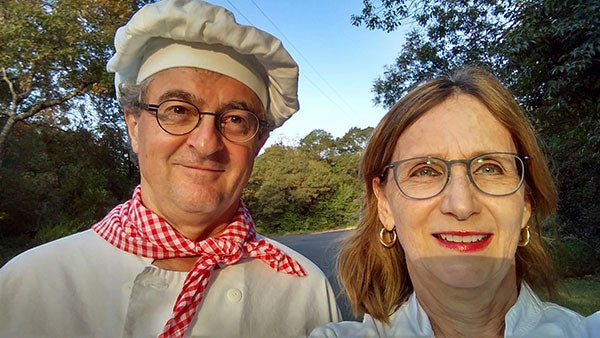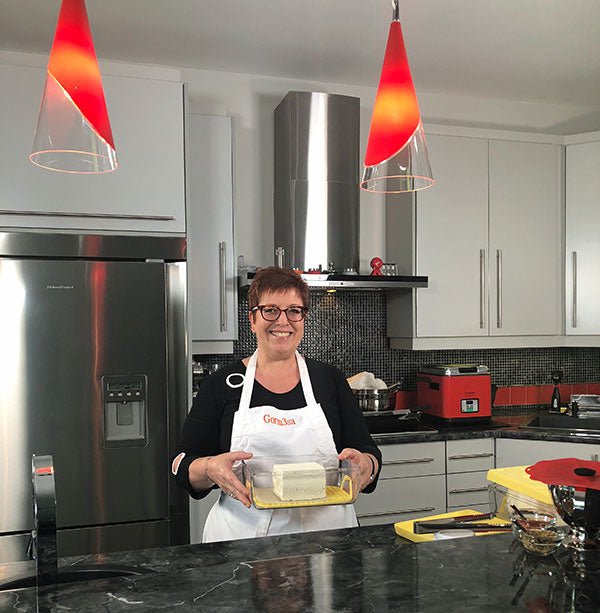It’s rare that both halves of a couple make cheese, so, we very seldom interview two people at once. With Steve and Jessica, we can see what a major advantage it is. They go to workshops together and they learn from each other’s experiences. Their cheese making really is “double the fun.”
Their Story
Jessica
My interest in artisanal foods has its origins in my Italian-American upbringing in a small town in rural South Jersey.
While my family was not farmers, all summer long we shopped at the roadside farm stands to buy the produce freshly picked in the surrounding fields, including strawberries, tomatoes, eggplants, peppers, broccoli, and more!
After moving to Austin with my husband Steve in the 1980s, I found it hard to find the fresh produce I took for granted.
In 2004, I joined the board of the Sustainable Food Center in Austin, whose mission is to support local farms and access to healthy food in Central Texas. This experience broadened my exposure to artisanal foods through the huge variety offered at farmers’ markets, including locally made cheeses.
One of the vendors, Eagle Mountain Farmhouse Cheese, was advertising a cheesemaking class at its facilities in Lipan, Texas. Steve and I were looking to learn a new cooking skill and decided to join the class held in December 2014, which was taught by Larry Faillace of Three Shepherds Cheese.
We learned so much in this introductory class that we returned to the advanced class the following year. And we’ve been making cheese in our kitchen ever since!
Steve
After many years working in cybersecurity and clean energy startups, I realized I knew almost nothing about the life sciences, so I started looking for practical ways to learn how life works.
First, I went to Paul Stamets’ excellent artisanal mushroom school in the cool damp Pacific Northwest. But, it was tough to produce mushrooms in the hot and dry Texas climate, though I’m still really interested in mycology.
Since I liked eating a wide variety of cheeses, I thought I could make cheese. (This was back when Jessica disliked complex cheeses!) I knew the process used rennet so, my first attempt used supermarket milk with that boxed supermarket pudding mix called “rennet,” and of course it failed.
I like learning new things, so cheesemaking classes and many books on “cheese science” later, I feel pretty skilled at making small batches of cheeses (2-4 gallons of raw cow’s milk). Feta was my entry point, and it worked out well, followed by Castle Blue (too complex for my skills at the time).
My Chaource was really good as I figured out how to manage humidity in our repurposed wine cooler. After I bought a spring-loaded cheese press from cheesemaking.com my possibilities grew, and I regularly make a Tomme de Savoie (based on Meryl Weinstein’s excellent books), washed-rind Raffine and Esrom (from Jim Wallace at cheesemaking,com, and Saint Marcellin (also from Jim Wallace).
I’ve been using a pH meter for a couple of years, and it helps me better know when to progress to the next step. Usually a recipe just says, “Wait 20 minutes,” but the differences between milk batches, ambient temperatures, and cultures makes that risky.
Another thing that really helped my cheese making was learning when and how to coat my pressed cheeses. I acquired a big industrial-size container of Paracoat, which I use regularly, followed by waxing for the Tommes.
Making Cheese Together
We’ve tried many recipes over the years, starting with feta and soft-ripened cheeses, then moving on to mozzarella, robiola, Camembert, Brie Nuit, and now to Spressa, Tomme de Savoie, washed rind Morbier, St Marcellin, and others. We love experimenting with different recipes.

Mozzarella
There have been many challenges. The first was finding a source for raw milk as it isn’t sold in grocery stores in Texas. We started using Mill-King, a low temp pasteurized non-homogenized milk available here.
Then, quite by coincidence, my hairdresser told me about a raw cow’s milk co-op that she headed up, which we promptly joined. Raw milk is available every two weeks, which fits well into our cheese making schedule.
We’ve tried making chevre with goat milk, once with ultra-pasteurized milk from the grocery store as an experiment because we had no source for raw goat milk. Even with the addition of calcium chloride, it failed to coagulate.

The second attempt, using raw goat milk from a farm about 30 miles away, was more successful, yielding four beautiful cheeses with mild flavor.
Other challenges included managing humidity; mozzarella failing to consolidate (although it is often seen as a beginners’ cheese); affinage requirements that didn’t fit in with travel schedule; high ambient temperatures for most of the year due to Texas climate; some cross-contamination with other fermentation projects; the sometimes conflicting directions in recipes for the same cheese, depending on the source; and keeping cheeses too long before eating them, to the point where they are inedible!
One of our biggest projects is making soft mold-ripened cheeses, such as brie and Camembert. Over the past few years, we’ve had little success in developing the creamy texture that makes these cheeses so delicious. The recipes typically prescribe a three-day salting and drying process, which may be too long for the high ambient temperature in our kitchen, typically 75-80F from late March through early November.
Jessica’s failed soft cheeses have become the primary ingredient of Liptauer cheese spread (recipe from 200 Easy Homemade Cheese Recipes by Debra Amrein-Boyes). But Steve’s Chaource and Saint Marcellin have been excellent.

Camembert in ripening boxes made on 6/16/21. Despite lack of success I (Jessica) keep trying! Nice mold coat but not very soft.
Making alpine style cheeses such as Spressa and Tomme de Savoie has been more successful, possibly due to brining and the longer aging process.
Currently, Jessica is working on a washed rind Morbier recipe. These styles seem to be less sensitive to fluctuations in humidity during affinage. We use the same method of placing these cheeses in plastic containers with draining mats and moistened paper towels, with successful outcomes.
We have a press …
The cave is a wine fridge that is re-purposed for cheese.
Managing the humidity in our “cave,” is challenging. We first tried placing cheeses directly on the shelves with open jars filled with water to add moisture. Next, we tried adding soaked clay plant pots to the fridge. Both methods were insufficient to maintain high humidity.
More successful is using plastic containers lined with several layers of draining mats, with a moistened paper towel at the bottom. Initially, we put mini-hygrometers in each container, but found the results inaccurate. So, we check the cheeses daily, wiping put the boxes and propping them open if too moist or wetting the paper towel if too dry.
We love sharing our successes with family and friends. Our adult daughter Rebecca has inherited our love for cooking, and is an expert baker! As a side note, our French friends actually prefer Steve’s Saint Marcellin to what he buys in France.
Experimenting with different cheese recipes, and having the results vary from batch to batch, is part of the fun of being non-professional cheesemakers. At the same time, learning how small changes affect the outcome leads to better cheese. The cheesemaking community we met at the American Cheese Society conferences in Denver and Pittsburgh gave us valuable tips in the subtleties of the science of cheese, and we attended the virtual ACS conference this year.

All stored in regular fridge for aging: In Formaticum paper, Raffine made on 4/8/21. In mold-ripening paper, Raffine made on 12/30/20. In foil with parchment paper underwrap, Morbier made on 4/7/21. In paracoat, Tomme made on 10/23/20. Waxed, Blue ByYou made on 6/3/20; Tomme made on 7/17/20 and 9/25/20.
Other Hobbies
Jessica
After careers in state government, high tech, and non-profits, I am now fortunate to have time for creative endeavors. My interests are running, yoga, photography, videography, painting, and Ikebana (Japanese flower arranging).
During the Covid lockdown, my days were often spent in making cheese, baking sourdough and yeasted breads, and learning food fermentation techniques.
As a photographer, I developed and taught a contemplative photography program for incarcerated teens. My work, along with that of the teens, was included in several group shows in Austin. Currently I coordinate a volunteer program that teaches meditation and yoga to incarcerated women in Texas State prisons.
Steve
Steve’s hobbies are meditation, hiking, cooking, and cycling. He spends a lot of time mentoring startups at the Austin Technology Incubator.
We both enjoy travel, and especially trips to Japan in recent years with our friend and chef, Hiroko Shimbo.
Together
Our yard is just over 1/3 acre, has rocky soil, and is partially terraced, making it suited to growing olive trees.
Until the snowpocalypse in February, there were 7 Arbequina olive trees in our backyard that yielded a huge harvest several years ago – Yes, we had a week of freezing weather with the low temp 8F, which was close to a record for Austin. Arbequina olives can survive down to 17F. We cut them to the ground and 4 of the 7 are sending shoots from the roots. The others may be totally gone. This is the same storm that knocked out the Texas electrical grid, and we were without power for several days with the temperature barely out of the single digits.
Between the 2 of us, we always have at least one fermentation project in progress, including kombucha and sourdough for Jessica and sake, amazake (traditional Japanese sweet rice drink), and pickles for Steve. I (Jessica) have also preserved Mexican plums from my tree in the style of Japanese umeboshi. And, to honor Jessica’s Italian heritage, last December, I made limoncello using Meyer lemons from a friend’s tree.
During Covid we made miso, with Hiroko Shimbo, and tofu, both using organic soybeans. Tofu making is somewhat similar to cheesemaking, in that soy milk is coagulated with a salt solution called nigari.
With our Mediterranean family backgrounds – my Italian and Steve’s Lebanese roots – our culinary heritages play a large role in what foods we prepare, grow, and share. Jessica’s grandfather operated a popular pizza parlor in her hometown, and reportedly took his recipe for tomato sauce to the grave with him! Steve’s family started and ran the largest chain of grocery stores in Maine from the 1930s through 1970s.










































































































































































